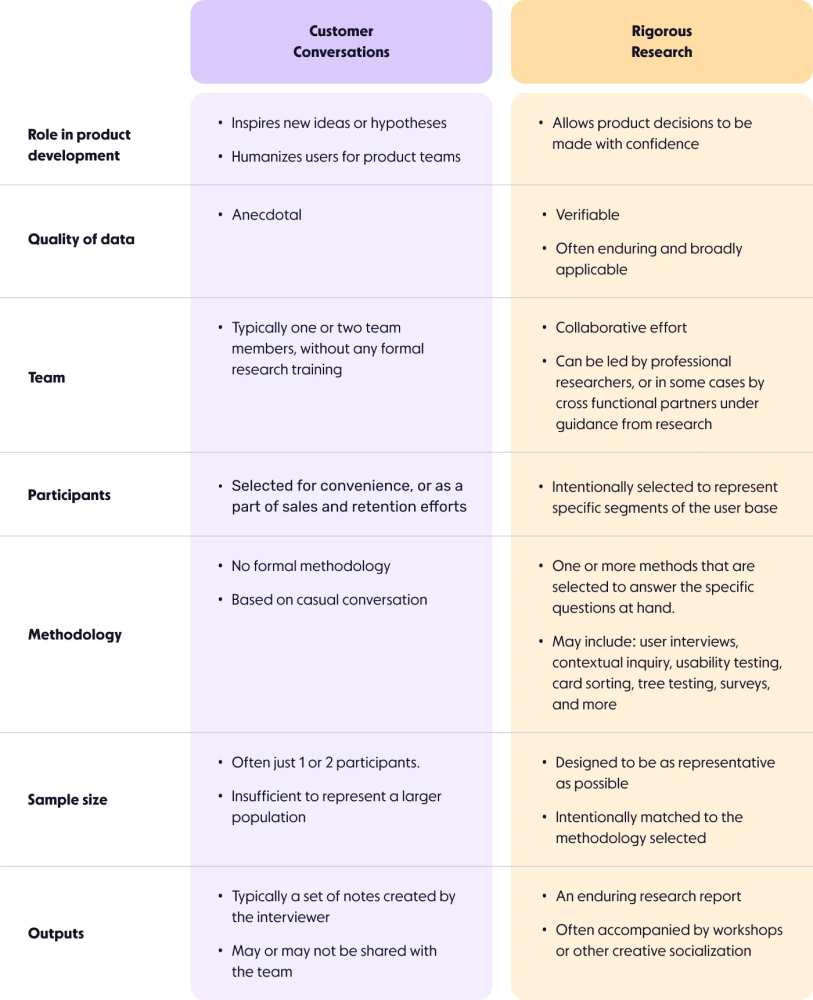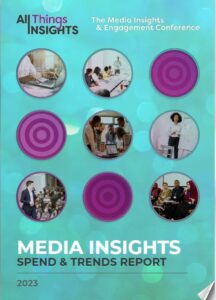Research-Driven Insights
Product development can further benefit from a rigorous research approach as opposed to just more casual conversations with clients through the sales or marketing team. In Christoper Nash’s LinkedIn article, “Rigorous research and customer conversations: how to use both effectively,” he makes the case that there are distinct differences between research conversations and more casual conversations. Both have their benefits in product development, as both support learning directly from customers.
Nash points out some of the differences and says, “Rigorous research is typically conducted by professional researchers, using very intentional methods, sample sizes, screening criteria and analysis techniques. Meanwhile, customer conversations are typically conducted by one product manager or executive, in more casual conversation with a smaller number of customers.”
In short, Nash notes that, “Customer conversations are valuable for building empathy and sparking new ideas, while rigorous research can help product developers make specific product decisions with confidence. When stakeholders and executives do not understand the difference between these two modes of inquiry, they may make consequential product decisions with misplaced confidence. Because someone spoke to a customer or two, they think of the decision as having been validated by “research,” when in fact, the data is anecdotal at best, and at worst, it could be completely false.”
Nash goes on to highlight in this chart some of the key differences between the two modes of communication with customers:

For the insights professional, clearly there is a more disciplined and defined approach to conversations with customers. In the LinkedIn article, Nash further breaks down the market research component into several categories that he feels are concepts to develop rigorous research:
- Defining appropriate research questions— distilling the multitude of things a team might want to know down to a focused and coherent set of goals for a particular study.
- Methodology selection— identifying the best methods to use to answer the defined questions reliably.
- Participant selection— identifying and recruiting the right people to effectively answer the relevant research questions.
- Sample size— understanding how the number of people you talk to relates to the relative confidence you should have in your findings.
- Objective inquiry— phrasing questions in a way that minimizes bias, and moderating sessions with consistency so that you collect consistent data.
- Disciplined analysis— analyzing data systematically and thoroughly to minimize confirmation bias and develop a set of learnings that are representative of a larger population.
- Appropriate humility— discerning and effectively communicating how reliable specific findings and recommendations actually are, and identifying other sources of information that might increase confidence.
The Power of Conversations
All Things Insights examined the customer in, “Improving the Customer Feedback Experience.” As the buyer journey becomes more complex, the customer satisfaction survey remains a foundational tool for the market researcher. With it, companies can measure consumer and brand sentiment among other factors. This isn’t just about bringing in new customers, but about retaining your older customers and making sure they are satisfied with their products or services. It’s a rather quick and convenient way to ask customers for their feedback, identify technical issues, and discover new opportunities. In addition, it helps maintain relevancy and a competitive edge while monitoring, and improving, progress and operations over time.
Looking forward to TMRE 2024? The conference, which will be held October 8 to 10, will feature a keynote, “Supercommunicators – The Power of Conversation and Hidden Language of Connection,” presented by Charles Duhigg, New York Times bestselling author & Pulitzer Prize-winning columnist at The New York Times Magazine. Why do some conversations succeed — while others fail? How does communication work within our brains, our families, our workplaces, and our communities? Based on Duhigg’s new book of the same name, the keynote is about what happens inside our minds when we open our mouths and ears. Supercommunicators know the importance of recognizing – and then matching – each kind of conversation, and how to hear the complex emotions, subtle negotiations, and deeply held beliefs that color so much of what we say and how we listen. In this talk, audiences will learn why some people are able to make themselves heard, and to hear others, so clearly. Duhigg shows how to recognize conversations and the tips and skills we need to navigate them more successfully. In the end, Duhigg delivers a simple but powerful lesson: With the right tools, we can connect with anyone. Register for TMRE 2024 here.
Understanding Customer Conversations
A rigorous research approach can significantly improve customer conversations by providing valuable insights into customer needs, preferences, and behaviors. This is a way to delve deeper into customer understanding, from identifying pain points, understanding the customer journey and segmentation. Optimizing the conversation with data further helps to focus training and resources through topic modeling, sentiment analysis and conversation analytics, which can help uncover additional trends and themes.
This is not to say that more casual conversations are irrelevant. Those conversations can indeed help inspire new ideas and more. Both avenues are beneficial. But with market research, the design of the conversation can be improved, ultimately leading to an enhanced customer experience and the building of brand trust. Rigorous research provides the foundation for creating meaningful and impactful customer conversations. By understanding customer needs, preferences, and behaviors, businesses can deliver exceptional experiences and build stronger customer relationships.
As Nash observes, “The key is to ensure that each mode of inquiry is used intentionally, responsibly, and transparently. Learnings from either mode should be shared with complete context about the methods employed and the confidence with which they are held. Use each mode for what it is good for, don’t confuse the two, and your product teams — and ultimately your users — will benefit from the increased understanding they both bring.”
Video courtesy of Harvard Business Review
Contributor
-

Matthew Kramer is the Digital Editor for All Things Insights & All Things Innovation. He has over 20 years of experience working in publishing and media companies, on a variety of business-to-business publications, websites and trade shows.
View all posts
































































































